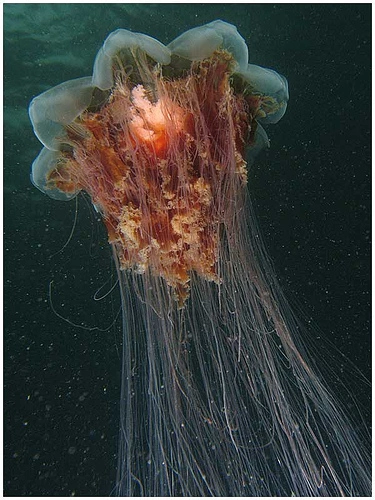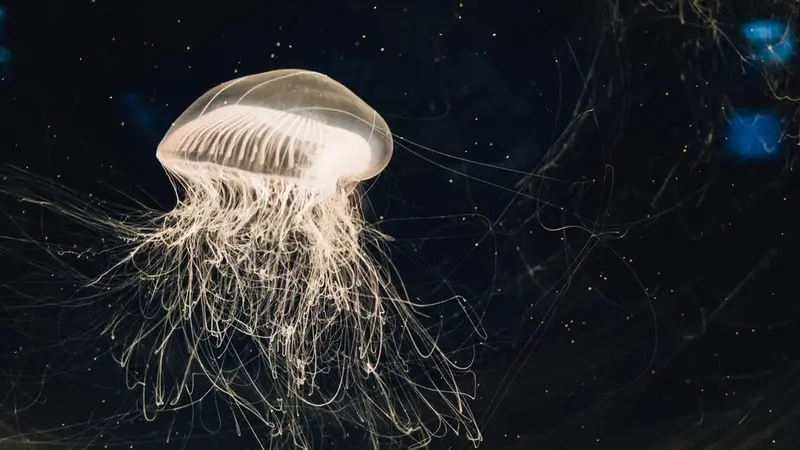The Lions Mane Jellyfish, scientifically known as Cyanea capillata, has captivated many’s imagination, notably in Sherlock Holmes’s ‘The Adventure of the Lion’s Mane.’ Contrary to its fearsome portrayal in popular culture, the lion’s mane jellyfish is relatively harmless to humans. A sting from this creature typically results in an itchy rash and mild burning sensation.
Related article: Where Do Jellyfish Live?
While the rash can be uncomfortable, especially for sensitive individuals, and the venom may trigger allergic reactions, such treatments as vinegar can effectively manage the sting.
Braving the Cold: Habitat and Survival
Lion’s mane jellyfish thrive in some of the most challenging marine environments. They inhabit the frigid waters of the Arctic Ocean and the Northern Pacific Ocean during the coldest months. Their range is primarily restricted to north of 42 degrees latitude, with no presence in the southern hemisphere.
Record-Breaking Size
The lion’s mane jellyfish is the largest species of jellyfish and the largest known animal on Earth. The 1870 discovery of a specimen in Massachusetts Bay revealed a jellyfish over 7 feet in diameter, with tentacles extending beyond 120 feet.
In the Arctic, however, lion’s mane jellyfish can grow even more prominent, with bells reaching up to 8 feet in diameter and tentacles stretching up to 150 feet, surpassing the length of the blue whale.

Size Variability and Appearance
The size of the lion’s mane jellyfish varies significantly with latitude. The largest specimens are found in the Arctic, while those in more southern regions, particularly between 40 and 42 degrees latitude, are noticeably smaller. These jellyfish have a bell diameter of up to 8 feet on average. Their tentacle length also diminishes in proportion to their overall size. Interestingly, their coloration is size-dependent: the largest are dark crimson, which lightens to orange or tan in smaller specimens.
Anatomy and Diet
Each of the eight lobes of a lion’s mane jellyfish’s bell houses 60 to 130 tentacles, and they possess several oral arms near the mouth to help transport food. Lion’s mane jellyfish are carnivorous, feeding on zooplankton, small fish, and ctenophores. They are also known to be cannibalistic, preying on other jellyfish species, such as moon jellies. Their predators include seabirds, larger fish, other jellyfish species, and sea turtles.
Facts about Lions Mane Jellyfish:
- Reproduction and Life Cycle: Lion’s mane jellyfish have a complex life cycle that includes sexual and asexual reproduction phases. They release eggs and sperm into the water, where fertilization occurs. The fertilized eggs develop into larvae, eventually settling on a substrate and transforming into polyps. These polyps can reproduce asexually, giving rise to free-swimming medusae, which grow into adult jellyfish.
- Bioluminescence: Some lion’s mane jellyfish are capable of bioluminescence. This means they can produce their own light, which is thought to be used to attract prey or defend against predators.
- Swimming Mechanism: Despite their size, lion’s mane jellyfish are weak swimmers. They rely on ocean currents for movement. However, they can control their vertical position in the water by expanding and contracting their bell-shaped body, allowing them to navigate to varying depths.
- Sensitivity to Environmental Changes: Lion’s mane jellyfish are sensitive to environmental changes, such as water temperature and salinity. Changes in these conditions can affect their distribution, abundance, and size.
- Ecological Indicator: The presence and population dynamics of lion’s mane jellyfish can indicate environmental conditions and changes in the marine environment, including climate change and pollution.
- Seasonal Appearance: In some regions, lion’s mane jellyfish are more commonly seen during certain seasons. For example, they are often more abundant in late summer and fall in the calmer waters of the Northern Hemisphere.
- Impact on Human Activities: Large swarms of lion’s mane jellyfish can sometimes impact fishing, tourism, and even power generation when they get entangled in fishing nets, clog cooling systems of power plants or deter swimmers and beachgoers.
Conclusion
The Lions Mane Jellyfish is a marvel of the marine world, demonstrating remarkable adaptations to survive in extreme conditions and achieving record sizes. Its relatively benign nature towards humans and its role in the ocean ecosystem make it a fascinating subject for study and admiration.
